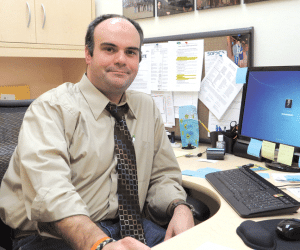Improvements Begin to Camp STAR Angelina
SPRINGFIELD — State Energy and Environmental Affairs (EEA) Secretary Richard K. Sullivan Jr. was on hand recently for a groundbreaking ceremony for improvements to Camp STAR Angelina in Springfield’s Forest Park. “The Patrick Administration is committed to creating open space and parks across the Commonwealth because recreational opportunities improve the lives of both residents and visitors,” Sullivan said. “We are especially thrilled to help make Camp STAR Angelina the first universally designed day camp in Western Mass.” The Patrick Administration provided $1.23 million to help fund the construction of a zero-depth entry pool and accessible bath house, a universal outdoor amphitheater, and an accessible trail to Porter Lake. The pool is expected to open in time for campers to use it this summer, and the amphitheater and trail are expected to be completed this fall. The city of Springfield is contributing $600,000 toward the project. These upgraded facilities will also be made available to the public for a wide range of programs and events, such as picnics, family reunions, swimming, school field trips, and outdoor theater. Camp STAR Angelina, situated in the 700-acre Forest Park, serves youth and young adults with and without disabilities, medical concerns, and hearing and visual impairments. “All of our residents, especially the youth of Springfield, deserve the opportunity to participate in outdoor recreation regardless of physical ability,” Springfield Mayor Domenic Sarno said. “Camp STAR Angelina will become the home of therapeutic recreation for the city.” Springfield is one of seven cities across Massachusetts receiving funding through EEA’s Signature Urban Parks program. Through this program, the Patrick administration seeks to revitalize urban communities by opening up or upgrading green spaces for outdoor recreation and improving access to natural resources like waterways and historic neighborhood landmarks. “This is a great investment in the Springfield community,” said state Sen. James Welch. “These improvements to Camp STAR Angelina will create a terrific resource for our residents.”
Five Area Finalists Chosen for Nonprofit Excellence Awards
WESTERN MASS. — The Massachusetts Nonprofit Network (MNN) recently announced that five nonprofits and nonprofit professionals in the Pioneer Valley and Berkshires have been selected as finalists for the 2014 Nonprofit Excellence Awards. They include the Berkshire Youth Development Project , which serves youth and young adults in Berkshire County; Jay Breines, CEO of the Holyoke Health Center, which provides low-cost medical care; Nonotuck Resources Associates Inc. in Florence, which improves service access and delivery to people with developmental and intellectual disabilities; Donovan Arthen, executive director of PeaceJam New England in Northampton, which matches Nobel Peace Prize laureates with youth in a mentorship program centering on service learning and taking action for positive change; and the Western Massachusetts Network to End Homelessness, which serves homeless and at-risk individuals and families across the region. The Excellence Awards will be presented at MNN’s celebration of Nonprofit Awareness Day, a statewide holiday on June 9 that highlights the work of the nonprofit sector and raises awareness of causes throughout Massachusetts. “Nonprofit Awareness Day was created to recognize the impact and importance of the more than 33,000 nonprofits and almost a half-million nonprofit employees that provide invaluable services and are the cornerstones of our communities,” said Rick Jakious, CEO of the Massachusetts Nonprofit Network. “The Excellence Award finalists truly exemplify the most innovative, creative, and effective work being done throughout the Commonwealth.”
State Gets Reprieve from ACA Compliance
WASHINGTON, D.C. — Federal officials have granted Massachusetts an additional year to transition to full compliance with the Affordable Care Act, giving state health insurers until 2017 to replace their criteria for setting small-business premium rates with federal criteria. It was the latest federal move to delay implementation of the health law aimed at expanding health insurance nationally. Under pressure from small-business owners who feared federal criteria used to determine rates would increase their insurance premiums, state officials had asked Obama administration officials for more time and flexibility in adapting the national standards. Federal officials agreed last year to give Massachusetts a three-year timetable. Patrick, in a statement, thanked the White House “for affording us this flexibility that will help our small businesses more smoothly transition into compliance with the Affordable Care Act.”
Non-residential Building Inches Down in March
BOSTON — Non-residential construction spending inched down in March, making it the third consecutive month in which spending declined. Non-residential construction spending fell 0.1% on a monthly basis in March but has risen 4.4% on a yearly basis, according to a May 1 release by the U.S. Census Bureau. Spending for the month totaled $568.5 billion on a seasonally adjusted, annualized basis. Anirban Basu, chief economist for Associated Builders and Contractors, said the report isn’t too worrisome. “The factors that have produced recent economic and construction slowdowns appear to be temporary for the most part and not a sign of emerging economic turbulence. Given recent reports of increased private-sector hiring, construction activity should pick up meaningfully during the second quarter.” Overall, seven of 16 non-residential construction subsectors posted increases in spending in March: highways and streets, lodging, office, transportation, water supply, manufacturing, and religious. Nine categories saw declines in March: communications, education, commercial, public safety, sewage and waste disposal, amusement and recreation, healthcare, conservation and development, and power.
State Recognizes Programs for Energy and Environmental Education
BOSTON — The state office of Energy and Environmental Affairs (EEA) recently honored 27 programs — 22 schools and five nonprofits — at the 20th annual Secretary’s Awards for Excellence in Energy and Environmental Education. “We are proud to recognize the students, teachers, and nonprofits raising awareness about energy and environmental issues affecting Massachusetts and the planet,” said EEA Secretary Richard K. Sullivan Jr. “The ideas, research, and knowledge being recognized today show the forward thinking of our youth and how ready they are for the challenges ahead.” Winners competed for $5,000 in awards, funded by the Massachusetts Environmental Trust with the intention to fund further environmental education initiatives at the schools. EEA solicited nominations in early 2014. Two of the honorees were from Western Mass: the Eco Club at Minnechaug Regional High School in Wilbraham (students in grades 9-12), and the Korpita Kids Green Team at Williamsburg Elementary School (grade 2 students and teacher Johanna Korpita).
STCC Student Wins Elevator-pitch Contest
SPRINGFIELD — Anthony Grandoit, a Springfield Technical Community College student took first place at a recent elevator-pitch competition, part of the annual awards ceremony and banquet for the Harold Grinspoon Charitable Foundation’s Entrepreneurship Initiative. Before a crowd of more than 450, Grandoit pitched the “Baby Keurig,” which he called a “faster, cleaner, convenient way to keep your baby fed.” Mike Mullen, a student at UMass Amherst, took second place for his business concept Kloudbook, a mobile app to keep track of contact information. Finally, Scott Abdow, a student at Greenfield Community College, took third place with Game On!, an event-based entertainment center for card and board gamers. Representatives from six area banks — Berkshire Bank, Country Bank for Savings, First Niagara Bank, PeoplesBank, United Bank, and Westfield Bank — once again sponsored the elevator-pitch competition and served as judges at the April 30 event at the Log Cabin Banquet and Meeting House in Holyoke. An elevator pitch is an overview of an idea for a new business. The name reflects the fact that a pitch can be delivered in the time span of an elevator ride, roughly 90 seconds. The term is used when an entrepreneur pitches an idea to a venture capitalist to receive funding. The live event featured 15 students representing each of the 14 participating local colleges: American International College, Amherst College, Bay Path College, Elms College, Greenfield Community College, Hampshire College, Holyoke Community College, Mount Holyoke College, Smith College, Springfield College, Springfield Technical Community College, UMass Amherst, Western New England University, and Westfield State University. The first-, second-, and third-place winners received $1,000, $750, and $500 respectively. Each student received $100 for participating.









